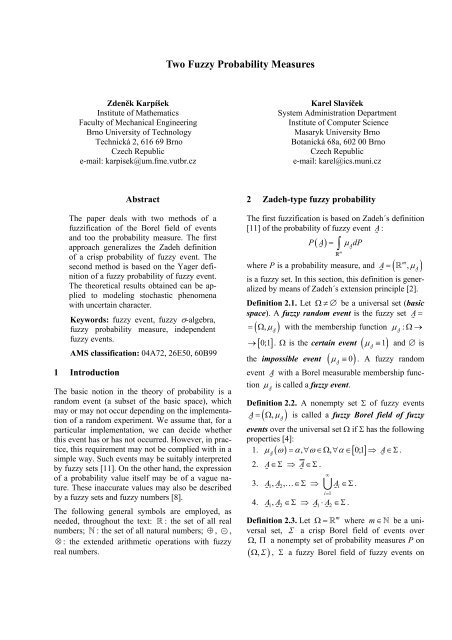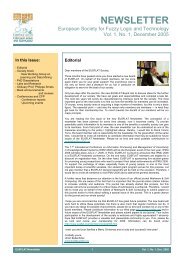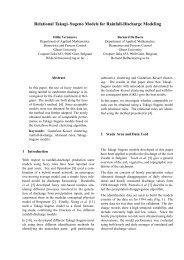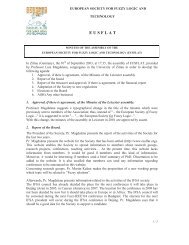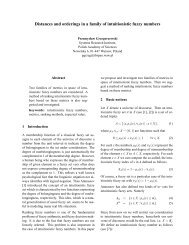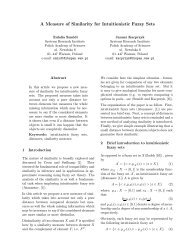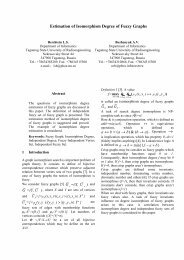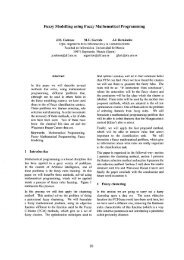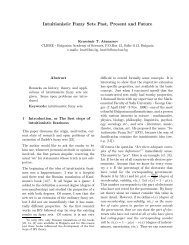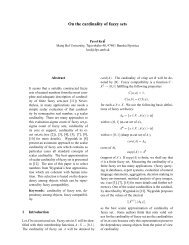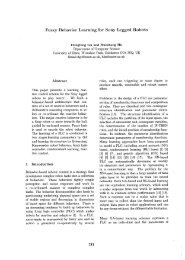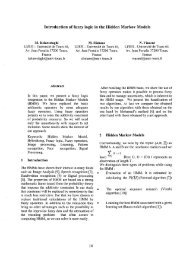Two fuzzy probability measures - EUSFLAT
Two fuzzy probability measures - EUSFLAT
Two fuzzy probability measures - EUSFLAT
You also want an ePaper? Increase the reach of your titles
YUMPU automatically turns print PDFs into web optimized ePapers that Google loves.
Zdeněk Karpíšek<br />
Institute of Mathematics<br />
Faculty of Mechanical Engineering<br />
Brno University of Technology<br />
Technická 2, 616 69 Brno<br />
Czech Republic<br />
e-mail: karpisek@um.fme.vutbr.cz<br />
<strong>Two</strong> Fuzzy Probability Measures<br />
Karel Slavíček<br />
System Administration Department<br />
Institute of Computer Science<br />
Masaryk University Brno<br />
Botanická 68a, 602 00 Brno<br />
Czech Republic<br />
e-mail: karel@ics.muni.cz<br />
Abstract 2 Zadeh-type <strong>fuzzy</strong> <strong>probability</strong><br />
The paper deals with two methods of a<br />
fuzzification of the Borel field of events<br />
and too the <strong>probability</strong> measure. The first<br />
approach generalizes the Zadeh definition<br />
of a crisp <strong>probability</strong> of <strong>fuzzy</strong> event. The<br />
second method is based on the Yager definition<br />
of a <strong>fuzzy</strong> <strong>probability</strong> of <strong>fuzzy</strong> event.<br />
The theoretical results obtained can be applied<br />
to modeling stochastic phenomena<br />
with uncertain character.<br />
Keywords: <strong>fuzzy</strong> event, <strong>fuzzy</strong> σ-algebra,<br />
<strong>fuzzy</strong> <strong>probability</strong> measure, independent<br />
<strong>fuzzy</strong> events.<br />
AMS classification: 04A72, 26E50, 60B99<br />
1 Introduction<br />
The basic notion in the theory of <strong>probability</strong> is a<br />
random event (a subset of the basic space), which<br />
may or may not occur depending on the implementation<br />
of a random experiment. We assume that, for a<br />
particular implementation, we can decide whether<br />
this event has or has not occurred. However, in practice,<br />
this requirement may not be complied with in a<br />
simple way. Such events may be suitably interpreted<br />
by <strong>fuzzy</strong> sets [11]. On the other hand, the expression<br />
of a <strong>probability</strong> value itself may be of a vague nature.<br />
These inaccurate values may also be described<br />
by a <strong>fuzzy</strong> sets and <strong>fuzzy</strong> numbers [8].<br />
The following general symbols are employed, as<br />
needed, throughout the text: : the set of all real<br />
numbers; : the set of all natural numbers; ⊕ , ,<br />
⊗ : the extended arithmetic operations with <strong>fuzzy</strong><br />
real numbers.<br />
The first fuzzification is based on Zadeh´s definition<br />
[11] of the <strong>probability</strong> of <strong>fuzzy</strong> event A :<br />
<br />
P( A) = ∫ µ AdP<br />
<br />
<br />
m<br />
R<br />
m<br />
where P is a <strong>probability</strong> measure, and A = ( , µ A )<br />
<br />
<br />
is a <strong>fuzzy</strong> set. In this section, this definition is generalized<br />
by means of Zadeh´s extension principle [2].<br />
Definition 2.1. Let Ω ≠∅ be a universal set (basic<br />
space). A <strong>fuzzy</strong> random event is the <strong>fuzzy</strong> set A =<br />
<br />
= ( Ω, µ A ) with the membership function µ A : Ω →<br />
<br />
→ [ 0;1]<br />
. Ω is the certain event ( µ A ≡ 1)<br />
and ∅ is<br />
<br />
the impossible event ( µ A ≡ 0)<br />
. A <strong>fuzzy</strong> random<br />
<br />
event A with a Borel measurable membership func-<br />
<br />
tion µ A is called a <strong>fuzzy</strong> event.<br />
<br />
Definition 2.2. A nonempty set Σ of <strong>fuzzy</strong> events<br />
A = ( Ω, µ A ) is called a <strong>fuzzy</strong> Borel field of <strong>fuzzy</strong><br />
<br />
<br />
events over the universal set Ω if Σ has the following<br />
properties [4]:<br />
µ ω = α, ∀ω∈Ω, ∀α∈ 0;1 ⇒ A∈Σ.<br />
1. ( ) [ ]<br />
2.<br />
A<br />
<br />
A∈Σ ⇒ A∈Σ.<br />
<br />
A, A , …∈Σ<br />
⇒ Ai∈Σ.<br />
<br />
3. 1 2<br />
∞<br />
∪<br />
i=<br />
1<br />
4. A1, A2∈Σ ⇒ A1⋅A2∈Σ. <br />
m<br />
Definition 2.3. Let Ω = where m ∈ be a universal<br />
set, Σ a crisp Borel field of events over<br />
Ω, Π a nonempty set of <strong>probability</strong> <strong>measures</strong> P on<br />
( Ω , Σ ) , Σ a <strong>fuzzy</strong> Borel field of <strong>fuzzy</strong> events on
A = Ω ∈Σ a <strong>fuzzy</strong> event. Let, further,<br />
= Π be such a <strong>fuzzy</strong> bunch on Π that<br />
<br />
<br />
∃P∈Π and P ( ) 1 P µ = . Then the <strong>fuzzy</strong> bunch P is<br />
<br />
<br />
called a <strong>fuzzy</strong> <strong>probability</strong> measure on Ω and the<br />
<strong>fuzzy</strong> <strong>probability</strong> of a <strong>fuzzy</strong> event A is the <strong>fuzzy</strong> set<br />
<br />
P( A ) = ( [ 0;1 ] , µ P( A)<br />
) where<br />
<br />
<br />
P( A)( p) =<br />
P ( P<br />
<br />
<br />
∀p∈[ 0;1]<br />
∈Π<br />
A = p dP ∫ µ<br />
=<br />
<br />
Ω<br />
m ( , Σ,<br />
P) <br />
<br />
A<br />
<br />
P ( ∅ ) = { 0}<br />
P ( Ω ) =<br />
<br />
P( A) = { 1}<br />
P( A)<br />
Σ<br />
<br />
( ) ( ) P A<br />
P( A)(1<br />
p<br />
n ⎛ ⎞ n<br />
a) P⎜ Ai⎟= ⊗P(<br />
Ai)<br />
,<br />
∏ i=<br />
1<br />
⎝ i=<br />
1 ⎠ <br />
n ⎛ ⎞ n ⎛ ⎞<br />
b) P⎜∑Ai⎟= {} 1 ⎜⊗⎡{} 1 P( Ai)<br />
.<br />
i=<br />
1 ⎣ ⎤<br />
⎦⎟<br />
⎝ i=<br />
1 ⎠ ⎝ ⎠<br />
µ sup µ )<br />
P∈Π<br />
∫ µ AdP=<br />
p<br />
<br />
Ω<br />
3 Yager-type <strong>fuzzy</strong> <strong>probability</strong><br />
The second fuzzification is based on Yager´s definition<br />
[10] of the <strong>fuzzy</strong> <strong>probability</strong> of <strong>fuzzy</strong> event A :<br />
<br />
P( A) = α { P( Aα) }<br />
α∈[<br />
0;1]<br />
µ = µ − ∀p∈[ 0;1]<br />
<br />
<br />
P( A)<br />
<strong>fuzzy</strong> number ) fu number.<br />
<br />
Ai<br />
∈<br />
<br />
i = 1, …,<br />
n<br />
∪<br />
for . If no measure P exists such that<br />
, we put µ P( A)(<br />
p ) 0 . The triplet<br />
<br />
m<br />
is called a <strong>fuzzy</strong> <strong>probability</strong> space on .<br />
where P is a <strong>probability</strong> measure and Aα is the<br />
α−cut of <strong>fuzzy</strong> set A . In this section, this definition<br />
<br />
is generalized and the necessary <strong>fuzzy</strong> structures are<br />
described [9]. Let U be a universal set, F ( U ) the<br />
Theorem 2.1. For any <strong>fuzzy</strong> event ∈Σ,<br />
we have:<br />
a) , { 1 } ,<br />
system of all <strong>fuzzy</strong> sets on U.<br />
Definition 3.1. The system of <strong>fuzzy</strong> sets M ⊆<br />
⊆ F ( U ) is called a <strong>fuzzy</strong> set ring if, for ∀Ai∈M ,<br />
<br />
i<br />
<br />
∈ , M b) for ∀A∈ ,<br />
<br />
c) p ) for ,<br />
has the following properties:<br />
1. Ai Aj<br />
. M<br />
d) ⇒ P( A zzy<br />
<br />
∪ ∈ <br />
<br />
2. Ai − Aj∈M . <br />
Theorem 2.2. For any set of <strong>fuzzy</strong> events Σ ,<br />
, we have:<br />
<br />
3. Ai∈M ∪ .<br />
i∈<br />
<br />
Ω , and ( , µ A ) <br />
<br />
P ( , µ P )<br />
a)<br />
b)<br />
⎛<br />
P⎜ ⎝<br />
⎞<br />
A ⎟=<br />
⎠<br />
⎛<br />
P⎜ ⎝<br />
⎞<br />
A ⎟=<br />
⎠<br />
n n<br />
∪ i {} 1 P⎜∩ Ai⎟,<br />
∑ {} 1 ⎜∏<br />
∀P∈Π A BdP µµ<br />
Definition 2.4. Fuzzy events AB , ∈Σ are inde-<br />
<br />
pendent if, for ,<br />
∫ ∫ AdP BdP<br />
µ = ⋅∫ .<br />
<br />
Ω Ω<br />
⎝ ⎠<br />
⎛<br />
P<br />
⎝<br />
⎞<br />
A ⎟.<br />
⎠<br />
i= 1 i=<br />
1<br />
n n<br />
Ai ∈Σ n<br />
<br />
i , , i ∀<br />
Fuzzy events , i = 1, … , , are mutually independent<br />
if, for … } {1, …, n , ∀P∈ Π,<br />
µ <br />
{ }<br />
1<br />
⎛ ⎞<br />
i i<br />
i= 1 i=<br />
1<br />
∫ µ A dP = µ<br />
i A dP<br />
j ∫ .<br />
ij<br />
Ω<br />
<br />
Ω j= 1 j=<br />
1 Ω<br />
<br />
k ⊆<br />
k k<br />
∏ ∏<br />
Definition 3.2. The system of <strong>fuzzy</strong> sets<br />
AB ,<br />
<br />
B AB ,<br />
<br />
x1 ≤ x2,<br />
x1 ≠ x2,<br />
then, for<br />
<br />
Ai ∈Σ = n<br />
<br />
and<br />
Theorem 2.3. If <strong>fuzzy</strong> events ∈Σ are independent,<br />
then the <strong>fuzzy</strong> events A , ; AB; , are<br />
also independent.<br />
Theorem 2.4. For any set of mutually independent<br />
∀y∈supp A<br />
x1 ≤ y ≤ x2,<br />
we have y∈ Aα. A convex or quasiconvex<br />
<strong>fuzzy</strong> set A is called a pseudo-convex <strong>fuzzy</strong><br />
<br />
set.<br />
<strong>fuzzy</strong> events , i 1, …, , we have:<br />
The reason for introducing the term quasi-convex<br />
is the demand for proper definition of convexity on a<br />
( U )<br />
M ⊆<br />
⊆ F<br />
∀Ai∈M is called a <strong>fuzzy</strong> set σ−algebra if, for<br />
, i ∈ , M<br />
<br />
<br />
M has the following properties:<br />
1. Ai ∪Aj∈ .<br />
<br />
2. U − Ai∈M . <br />
<br />
3. Ai∈M ∪ .<br />
<br />
i∈<br />
Definition 3.3. Let a <strong>fuzzy</strong> set A∈F( U)<br />
have the<br />
<br />
finite support supp A . Let U be a complete ordered<br />
<br />
set with ≤ as the ordering relation. The <strong>fuzzy</strong> set A<br />
<br />
is called a quasi-convex if α−cut Aα has, for<br />
]<br />
∀α∈ (0;1 , the following property: if x1, x2∈ Aα,
discrete universe. We need this for random variables<br />
with discrete distribution laws.<br />
∪ is finite.<br />
<br />
1. The set α( M ) = α(<br />
A)<br />
2. If A ∈ M and B are <strong>fuzzy</strong> sets such that, for<br />
<br />
∀αi∈α( A ) , α i > 0,<br />
we have Aα = B<br />
i α , then<br />
i+ 1<br />
<br />
B ∈ M<br />
Definition 3.4. The normal and pseudo-convex<br />
<strong>fuzzy</strong> set a = ( ,<br />
µ a ) is called a generalized <strong>fuzzy</strong><br />
<br />
<br />
number. The set of all generalized <strong>fuzzy</strong> numbers<br />
.<br />
∗<br />
we denote by A .<br />
<br />
3. If A ∈ M and B are <strong>fuzzy</strong> sets such that, for<br />
<br />
∀αi∈α( A ) , α i > 0,<br />
we have AαB i+<br />
1 αi<br />
<br />
= , then<br />
B ∈ M<br />
Definition 3.5. Let M ⊆ F ( U ) be a <strong>fuzzy</strong> set<br />
σ−ring on U. A <strong>fuzzy</strong> set function λ : M<br />
∗<br />
→ A is<br />
.<br />
<br />
<br />
called a <strong>fuzzy</strong> measure on M if λ has the follow-<br />
Theorem 3.2. Let M<br />
ing properties:<br />
be a complete <strong>fuzzy</strong> set σ−algebra<br />
on U. Then the set<br />
1. suppλ ( A)<br />
⊆ + for ∀A∈M .<br />
M = { A⊆U ∃A∈M , α∈ α(<br />
M <br />
) ; A= Aα} <br />
<br />
<br />
2. For ∀A∈ M where i ∈<br />
<br />
is a set σ−algebra.<br />
⎛ ⎞<br />
λ⎜ Ai⎟= λ(<br />
Ai)<br />
∪<br />
⎝i∈ ∪ .<br />
⎠ i∈<br />
<br />
Theorem 3.3. Let M be the <strong>fuzzy</strong> set σ−algebra<br />
generated by a set σ−algebra M, P <strong>probability</strong> meas-<br />
3. λ ( ∅ ) = { 0}<br />
.<br />
∗<br />
ure on M. The <strong>fuzzy</strong> set function P: M<br />
<br />
→ A where<br />
Let M<br />
<br />
( ) = α∈[<br />
0;1]<br />
}<br />
be a <strong>fuzzy</strong> set σ−algebra on U. A finite<br />
( )<br />
<strong>fuzzy</strong> measure P such that PU ( ) = { 1}<br />
is called a<br />
( )<br />
<br />
<strong>fuzzy</strong> <strong>probability</strong> measure.<br />
{<br />
µ P A p sup α<br />
P Aα = p<br />
is a <strong>fuzzy</strong> <strong>probability</strong> measure. We say that P is<br />
<br />
Theorem 3.1. Let M be a set σ−algebra on U,<br />
generated by P.<br />
{ 0 0 1<br />
n i }<br />
( M ) = = < < < ∈(<br />
)<br />
α α α α α<br />
0;1 a finite<br />
set of real numbers with the following property:<br />
. Let be a sequence<br />
α∈α( M ) ⇒ ( 1−α) ∈α( M ) A of sets A = Ai () ∈MAi () ⊆ Ai ( −1;<br />
) i { 1, ,n}<br />
{ }<br />
∈ … .<br />
Then the family of <strong>fuzzy</strong> sets<br />
M = { AAα = Ai () ; Ai () ∈A i<br />
} <br />
<br />
<br />
generated by the system of sequences A is a <strong>fuzzy</strong><br />
set σ−algebra. We say that the <strong>fuzzy</strong> set σ−algebra<br />
<br />
M is generated by the set σ−algebra M.<br />
Now we can ask if and when we are able to generate<br />
a crisp set σ−algebra from a <strong>fuzzy</strong> set σ−algebra.<br />
One interesting class of <strong>fuzzy</strong> set σ−algebras<br />
that are able to generate a crisp σ−algebra is given<br />
by the following definition.<br />
be a <strong>fuzzy</strong> set. A is<br />
<br />
<br />
called a step <strong>fuzzy</strong> set, if the set<br />
Definition 3.6. Let A∈F( U)<br />
{ 0;1 ; A }<br />
( A) [ ] x U ( x)<br />
α = α ∈ ∃ ∈ µ = α ,<br />
<br />
<br />
is finite. The set α ( A)<br />
is called a set of member-<br />
<br />
ship degrees of the <strong>fuzzy</strong> set A .<br />
<br />
Definition 3.7. A family of step <strong>fuzzy</strong> sets M is<br />
called complete if has the following properties:<br />
A∈M <br />
Definition 3.8. Let ( UMP , , ) be a <strong>probability</strong><br />
space, M the <strong>fuzzy</strong> set σ−algebra generated by the<br />
set σ−algebra M, P the <strong>fuzzy</strong> <strong>probability</strong> measure on<br />
<br />
M generated by the <strong>probability</strong> measure P. The<br />
UMP , , is a <strong>fuzzy</strong> <strong>probability</strong> space, and<br />
triplet ( )<br />
<br />
UM is generated by the <strong>probability</strong> space<br />
( )<br />
, ,P <br />
( , ,P)<br />
UM . A <strong>fuzzy</strong> set A∈ is called a <strong>fuzzy</strong><br />
random event. A <strong>fuzzy</strong> number<br />
<br />
M<br />
P( A)<br />
is called a<br />
<br />
<strong>fuzzy</strong> <strong>probability</strong> of the <strong>fuzzy</strong> random event A .<br />
<br />
Definition 3.9. Let A be a <strong>fuzzy</strong> set on a universal<br />
<br />
set U,<br />
µ A<br />
∗<br />
<br />
A x<br />
<br />
µ A<br />
<br />
:0 [ ]<br />
( ) =<br />
;1→U<br />
the membership function. A function<br />
∗<br />
(if it exists) where µ ( α)<br />
A<br />
<br />
= x , iff<br />
µ α , is called a quasi-inverse membership<br />
function of the <strong>fuzzy</strong> set A .<br />
<br />
Theorem 3.4. For ∀AB , ∈M, , A⊆B ∀α∈ [ 0;1]<br />
,<br />
<br />
∗ ∗<br />
µ α µ α .<br />
we have ( )( ) ( )( )<br />
P A ≤ P B<br />
<br />
<br />
Theorem 3.5. For ∀A∈ M , , we have:<br />
∀α∈ [0;1]<br />
<br />
∗<br />
a) µ ( ) ( α)<br />
= P( Aα) ,<br />
P A
) ( p)<br />
µ = supα<br />
P( A)<br />
<br />
∗<br />
P( A)<br />
( ) = p<br />
<br />
µ α<br />
. ω j<br />
Definition 3.10. Fuzzy random events AB , ∈ M<br />
<br />
independent if random events<br />
<br />
[<br />
are<br />
Aα, Bβ<br />
are independ-<br />
ent for ∀αβ , ∈ 0; 1 . Fuzzy random events i ,<br />
<br />
, n,<br />
are mutually independent if random<br />
events Ai<br />
∈ A M<br />
i = 1, …<br />
α are mutually independent for ∀αi ∈<br />
[ 0;1]<br />
∈ , i = 1, …,<br />
n.<br />
i<br />
]<br />
Theorem 3.6. If <strong>fuzzy</strong> random events AB , ∈ M<br />
<br />
where<br />
<br />
M is a complete <strong>fuzzy</strong> set σ−algebra are<br />
independent, then the <strong>fuzzy</strong> random events AB ,<br />
;<br />
AB , ; ,<br />
AB are also independent.<br />
<br />
Theorem 3.7. For any two independent <strong>fuzzy</strong> random<br />
events AB , ∈ M and for any set of mutually<br />
independent <strong>fuzzy</strong> random events ,<br />
, we have:<br />
<br />
<br />
Ai∈M n<br />
<br />
<br />
i = 1, …,<br />
a) P( A∩ B) = P(<br />
A) ⊗P(<br />
B)<br />
<br />
n ⎛ ⎞ n<br />
b) P⎜ Ai⎟= ⊗P(<br />
Ai)<br />
.<br />
∩ i=<br />
1<br />
⎝ i=<br />
1 ⎠ <br />
4 Examples<br />
Example 4.1. (Zadeh-type <strong>fuzzy</strong> <strong>probability</strong>)<br />
We have a <strong>fuzzy</strong> <strong>probability</strong> (<strong>fuzzy</strong> bunch) P on<br />
<br />
the universal set<br />
bership function:<br />
{ P, P , P, P}<br />
,<br />
Π= with the mem-<br />
1 2 3 4<br />
P i<br />
1 P 2 P 3 P 4 P<br />
( ) P<br />
P i µ <br />
0.6 0.8 1.0 0.5<br />
where <strong>probability</strong> <strong>measures</strong> P for i = 1,2,3,4 on the<br />
basic space Ω= are given:<br />
ω j<br />
P i<br />
{ 1, 2,3, 4,5 }<br />
i<br />
1 2 3 4 5<br />
P 1 0.20 0.20 0.20 0.20 0.20<br />
P 2 0.30 0.25 0.20 0.15 0.10<br />
P 3 0.10 0.15 0.20 0.25 0.30<br />
P 4 0.28 0.18 0.08 0.18 0.28<br />
Let <strong>fuzzy</strong> events Ak for k = 1,2,3 have the member-<br />
<br />
ship functions:<br />
1 2 3 4 5<br />
Ak <br />
A1 <br />
1.0 0.5 0.0 0.0 0.0<br />
A2 0.0 0.5 1.0 0.5 0.0<br />
<br />
A3 0.0 0.0 0.0 0.5 1.0<br />
<br />
The calculated <strong>fuzzy</strong> probabilities of <strong>fuzzy</strong> events<br />
are:<br />
P i µ <br />
i ( ) P<br />
( )<br />
Pi A1 <br />
( )<br />
Pi A2 <br />
( )<br />
Pi A3 <br />
1 0.6 0.300 0.400 0.300<br />
2 0.8 0.425 0.400 0.175<br />
3 1.0 0.175 0.400 0.425<br />
4 0.5 0.370 0.260 0.370<br />
A plot of the membership function of <strong>fuzzy</strong> <strong>probability</strong><br />
P( A1)<br />
is shown in Fig. 4.1.<br />
<br />
µ<br />
1<br />
0,8<br />
0,6<br />
0,4<br />
0,2<br />
0<br />
0 0,2 0,4 0,6 0,8 1<br />
p<br />
Fig. 4.1<br />
A plot of the membership function of <strong>fuzzy</strong> <strong>probability</strong><br />
P( A1)<br />
is shown in Fig. 4.2.<br />
<br />
µ<br />
1<br />
0,8<br />
0,6<br />
0,4<br />
0,2<br />
0<br />
0 0,2 0,4 0,6 0,8 1<br />
p<br />
Fig. 4.2
A plot of the membership function of <strong>fuzzy</strong> <strong>probability</strong><br />
P( A1)<br />
is shown in Fig. 4.3.<br />
<br />
µ<br />
1<br />
0,8<br />
0,6<br />
0,4<br />
0,2<br />
0<br />
0 0,2 0,4 0,6 0,8 1<br />
p<br />
Fig. 4.3<br />
Example 4.2. (Yager-type <strong>fuzzy</strong> <strong>probability</strong>)<br />
Suppose a fair coin is flipped ten times. Let Ai<br />
be<br />
the random event "head faces up i-times",<br />
i = 0,...,10 . The random event i has the <strong>probability</strong><br />
A<br />
⎛10⎞ −10<br />
P( Ai)<br />
= ⎜ 2<br />
i<br />
⎟<br />
⎝ ⎠<br />
from the binomial distribution Bi(10;1/2):<br />
A i A0 A1 A2 A3<br />
P 2 -10<br />
10(2 -10 ) 45(2 -10 ) 120(2 -10 )<br />
A i A4 A5 A6 A7<br />
P 210(2 -10 ) 252(2 -10 ) 210(2 -10 ) 120(2 -10 )<br />
A i A8 A9 A10<br />
P 45(2 -10 ) 10(2 -10 ) 2 -10<br />
Let <strong>fuzzy</strong> random events:<br />
B : “head faces up seldom”,<br />
<br />
C : “head faces up sometimes”,<br />
<br />
D : “head faces up many times”,<br />
<br />
have the membership functions on the universal set<br />
U = A ,..., A 0 :<br />
{ }<br />
A i<br />
µ<br />
µ B<br />
<br />
µ C<br />
<br />
µ D<br />
<br />
0 1<br />
A0 A1 A2 A3<br />
1 1 0.9 0.7<br />
1 1 1 0.9<br />
0 0 0 0<br />
A i<br />
µ<br />
µ B<br />
<br />
µ C<br />
<br />
µ D<br />
<br />
A i<br />
µ<br />
µ B<br />
<br />
µ C<br />
<br />
µ D<br />
<br />
A4 A5 A6 A7<br />
0.4 0 0 0<br />
0.6 0.2 0 0<br />
0 0 0 0.3<br />
A8 A9 A10<br />
0 0 0<br />
0 0 0<br />
0.8 1 1<br />
The calculated <strong>fuzzy</strong> probabilities P( B)<br />
and P( D)<br />
<br />
<br />
have the membership functions:<br />
, PC ( ) ,<br />
<br />
p 11(2 -10 ) 56(2 -10 ) 176(2 -10 ) 386(2 -10 )<br />
µ P( B)<br />
<br />
1 0.9 0.7 0.4<br />
p 56(2 -10 ) 176(2 -10 ) 386(2 -10 ) 638(2 -10 )<br />
µ P( C)<br />
<br />
p 11(2 -10 ) 56(2 -10 ) 176(2 -10 )<br />
µ P( D)<br />
<br />
1 0.9 0.6 0.2<br />
1 0.8 0.3<br />
The membership functions of the <strong>fuzzy</strong> probabilities<br />
P( B)<br />
, PC ( ) and P( D)<br />
are plotted in Fig. 4.4.<br />
<br />
µ<br />
1<br />
0,8<br />
0,6<br />
0,4<br />
0,2<br />
0<br />
0 0,2 0,4 0,6 0,8 1<br />
p<br />
Fig. 4.4<br />
B<br />
C<br />
D
5 Conclusion<br />
We have presented two different <strong>fuzzy</strong> <strong>probability</strong><br />
models. As compared to the second model, the first<br />
one can also deal with possible uncertainty precarious<br />
information about the observed <strong>probability</strong> distribution.<br />
The first fuzzification is based on the expected<br />
value of the membership function of a <strong>fuzzy</strong><br />
event with respect to the <strong>fuzzy</strong> bunch of <strong>probability</strong><br />
<strong>measures</strong> [2]. The second fuzzification, on the contrary,<br />
assumes only one <strong>probability</strong> measure and its<br />
concept is nearer the classical theory of <strong>probability</strong>.<br />
The first model is relatively flexible and has already<br />
been implemented on a PC to calculate reliability [3,<br />
4]. The second model is intensively examined [9]<br />
and we expect its major application to reliability<br />
calculation as well.<br />
Acknowledgements<br />
The paper was supported by research design CEZ:<br />
J22/98: 261100009 “Non-traditional methods for<br />
investigating complex and vague systems”.<br />
References<br />
[1] U. Höhle (1976). Maße auf unscharfen Mengen.<br />
Z. Wahrsch. Verw. Geb. 36, p. 179-188.<br />
[2] Z. Karpíšek (2000). Fuzzy Probability and its<br />
Properties. In Mendel 2000. 6 th International<br />
Conference on Soft Computing, Brno 2000, p.<br />
262-266. ISBN 80-214-1609-2.<br />
[3] Z. Karpíšek (2001). Fuzzy Probability Distribution<br />
– Characteristics and Models. In Proceedings<br />
East West Fuzzy Colloquium 2001.<br />
9 th Zittau Fuzzy Colloquium, Zittau, 2001, p.<br />
36-45. ISBN 3-9808089-0-4.<br />
[4] Z. Karpíšek (2002). The Fuzzy Reliability<br />
with Weibull Fuzzy Distribution. In Proceedings<br />
East West Fuzzy Colloquium 2002.<br />
10 th Zittau Fuzzy Colloquium, Zittau, 2002, p.<br />
33-42. ISBN 3-9808089-2-0.<br />
[5] E. P. Klement (1980). Fuzzy σ-algebras and<br />
Fuzzy Measurable Functions. Fuzzy Sets and<br />
Systems, 4 (1980), p. 83-93.<br />
[6] E. P. Klement (1982a). A Theory of Fuzzy<br />
Measures: A Survey. In: Gupta, M. M. / Sanchez,<br />
E. Fuzzy information and decision processes,<br />
59-65. Amsterdam / New York: North-<br />
Holland.<br />
[7] E. P. Klement (1982b). Some Remarks on a<br />
Paper by R. R. Yager. Information Sciences<br />
27, p. 211-220.<br />
[8] G. J. Klir, B. Yuan (1995). Fuzzy Sets and<br />
Fuzzy Logic. 1 st ed. Prentice Hall, New Jersey,<br />
1995. ISBN 0-13-101171-5.<br />
[9] K. Slavíček (2002). Fuzzy pravděpodobnostní<br />
míra (Fuzzy Probability Measure). PhD Thesis.<br />
FME BUT, Brno 2002, pp. 49.<br />
[10] R. R. Yager (1979). A Note on Probabilities<br />
on Fuzzy Events. In Information Science (18),<br />
Elsevier 1979, p. 113-129.<br />
[11] L. A. Zadeh (1968). Probability Measures and<br />
Fuzzy Events. J. of Math. Analysis and Applications,<br />
23(2), p. 421-427.


